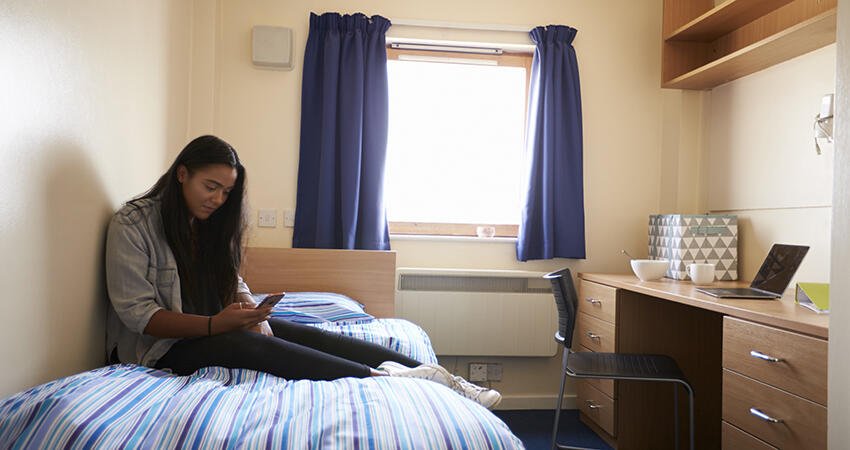
(Monkey Business Images/Shutterstock)
Poor Air Quality in Campus Housing Is Hurting Students. How Can Higher Education Institutions Help?
Students in higher education institutions across the United States have returned to campus after periods of remote schooling, and many have been met with mold, dampness, and other air quality issues in their on-campus housing.
The University of Rhode Island received 120 reports of possible mold in dorms, and Virginia Commonwealth University (VCU) temporarily closed one of its dorms because of elevated mold levels. The University of Georgia received 250 complaints about mold in dorms, and Howard University students organized a historic nine-day sit-in to protest mold found in 34 rooms, among other housing conditions and schooling issues.
These news stories highlight the important, but often overlooked, role of colleges and universities as housing providers for students. If colleges and universities want their students to succeed, higher education institutions should understand the link between quality housing and students’ health and improve housing options accordingly.
Are universities and colleges landlords?
Universities and colleges are most frequently discussed as providers of education, but they are also large players in real estate and property management.
Columbia University is one of the largest property owners in New York City. When students live in on-campus housing, the university serves as the landlord and sets the terms and costs of housing.
Despite this role, higher institutions often have competing funding interests and do not always prioritize the funding needed to maintain the quality of their housing portfolio. Instead, funding may go to the construction of newer buildings. By doing so, universities may neglect maintenance requests, creating a backlog. Gordian and APPA Leadership in Educational Facilities found that schools spend about $37 billion annually to operate and maintain buildings, yet there is a $112.3 billion maintenance backlog (PDF).
How does indoor air quality affect students’ health and educational outcomes?
For many students, poor indoor air quality in on-campus housing has caused physical health problems. Many dorm rooms have air quality issues because of aging buildings with small, underlit rooms and limited airflow. Because interior living spaces harbor moisture, these features create the perfect breeding ground for mold.
Exposure to mold—a common indoor air pollutant found in dormitories—can cause symptoms such as sneezing, stuffy nose, red or itchy eyes or skin, and chest tightness. These symptoms can be seasonal or long term and more severe, leading to pneumonia, asthma, and other respiratory infections.
Poor housing quality can also affect students’ mental health, both because they are exposed to hazardous living situations and because it can force students to move and experience housing instability. Research shows poor housing quality and instability has negative consequences on mental health and psychological well-being. Low-quality housing is associated with depression, anxiety, and low levels of motivation, while housing instability (PDF) is associated with anxiety and depression. Poor health conditions can hurt academic outcomes.
Displacement from residences because of air quality can also cause housing instability, which further affects academic achievement. At VCU, elevated mold levels displaced 414 students from their dorms, and at Howard University, flooding required students to move all their belongings and evacuate their dorm for two weeks. Research shows changing living situations is stressful, which can affect students’ test scores.
How can colleges and universities ensure their housing options don’t hurt their students?
After finding mold or dampness, universities often install dehumidifiers and perform air-quality tests. However, higher education administrators can be proactive in their approach to ensure quality housing for their students and limit damaging air quality problems. Universities can consider adopting the following measures to change how they invest in housing to support their students.
- Modernize dormitories and on-campus housing and ventilation.
Many universities’ budgets (PDF) do not include enough funding to cover the backlog of maintenance and renovations needed in campus dorms. Research has shown proper mechanical-ventilated buildings reduce allergy cases, increased living area decrease the annual rate of upper respiratory infections, and construction age lowers incidence rate of mental health diagnoses.
To promote air quality measures, such as adequate ventilation systems in student housing, higher education institutions can direct more funding to upgrade aging facilities and HVAC systems. Other preventative solutions include renovating rain guards, waterproofing foundations, and installing central air in buildings.
Though there may be limitations on how private donations can be used for construction or renovation, nonprivate funds are available for building modifications, including state-issued bonds and grants, federal program dollars such as financing from the US Department of Agriculture or the agency’ Rural Housing Service, and bond issues. These funding sources have been used for capital projects at colleges and universities across the US.
- Prioritize maintenance staffing.
Many university housing and facility services are inundated by maintenance orders or lack the capacity to take on mold removal requests. Students have reported the inability of student services and facility offices to heed their complaints, sometimes outright refusing to acknowledge the issues. Schools need to ensure funding is earmarked for maintenance aligned with a comprehensive plan.
- Listen to students.
Student voices have been a powerful force for effecting change. At Howard University, student demands included the reinstatement of affiliate board positions for students and alumni to ensure student priorities are reflected in the allocation of the school’s resources to further fund solutions to housing quality issues. The Atlanta Student Movement Takeover created the HBCU Student Quality of Life Agreement through which Clark Atlanta University committed to engaging a third party to conduct inspections of all on-campus student housing and complete repairs within 10 months. The Quality of Life Agreement also includes compensation for students temporarily displaced by housing repairs. Universities should create formal feedback mechanisms for students to voice complaints and a platform for constructive dialogue between key university personnel and students.
The pandemic has spotlighted the importance of living conditions. Higher education institutions seeking to address poor air quality in university housing should listen to residents and shift funding to ensure their housing infrastructure promotes positive health and economic outcomes for their students.


